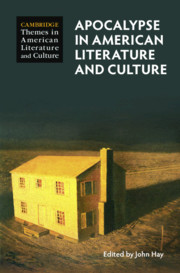Book contents
- Apocalypse in American Literature and Culture
- Cambridge Themes in American Literature and Culture
- Apocalypse in American Literature and Culture
- Copyright page
- Contents
- Figures
- Contributors
- Introduction The United States of Apocalypse
- Part I America as Apocalypse
- Part II American Apocalypse in (and out of) History
- Part III Varieties of Apocalyptic Experience
- Chapter 17 New History for a New Earth
- Chapter 18 W. E. B. Du Bois’s Apocalyptic Ambivalence
- Chapter 19 The Empty Cities of Urban Apocalypse
- Chapter 20 The Planetary Futures of Eco-Apocalypse
- Chapter 21 The Last Laughs of Doomsday Humor
- Chapter 22 The Catastrophic Endgames of Young Adult Literature
- Chapter 23 Apocalyptic Trauma and the Politics of Mourning a World
- Chapter 24 Posthuman Postapocalypse
- Further Reading
- Index
Chapter 20 - The Planetary Futures of Eco-Apocalypse
from Part III - Varieties of Apocalyptic Experience
Published online by Cambridge University Press: 03 December 2020
- Apocalypse in American Literature and Culture
- Cambridge Themes in American Literature and Culture
- Apocalypse in American Literature and Culture
- Copyright page
- Contents
- Figures
- Contributors
- Introduction The United States of Apocalypse
- Part I America as Apocalypse
- Part II American Apocalypse in (and out of) History
- Part III Varieties of Apocalyptic Experience
- Chapter 17 New History for a New Earth
- Chapter 18 W. E. B. Du Bois’s Apocalyptic Ambivalence
- Chapter 19 The Empty Cities of Urban Apocalypse
- Chapter 20 The Planetary Futures of Eco-Apocalypse
- Chapter 21 The Last Laughs of Doomsday Humor
- Chapter 22 The Catastrophic Endgames of Young Adult Literature
- Chapter 23 Apocalyptic Trauma and the Politics of Mourning a World
- Chapter 24 Posthuman Postapocalypse
- Further Reading
- Index
Summary
Environmental fiction and nonfiction writers began to use secular apocalypse in the 1960s and continue to do so as the emphasis has shifted over time from scenarios of pollution and population growth to biodiversity loss and to climate change and its consequences: natural disasters, refugee crises, and increased inequality. It has sometimes been considered environmentalism’s most powerful narrative strategy. But environmental projections of apocalyptic futures in popular-scientific texts must contend with the difficulty of balancing known facts and imagined futures. Fictional portrayals of eco-apocalypse, meanwhile, often rely on narrative templates that emphasize the breakdown of civic institutions and explore changing family configurations under these circumstances. But whereas the collapse of societies is intended as a warning about possible real-live developments, it is often portrayed without any accompanying imagination of new social structures. Eco-apocalyptic narrative therefore confronts the challenges of trivialization and spectacularization, with future environmental disasters so common in fiction and film that they have lost much of their ability to inspire fear or activism. This chapter argues that apocalyptic narrative no longer has much force as a strategy of environmental communication or aesthetics. The more promising forms of eco-futurist narrative are those seeking to outline new social forms that can emerge from current ecological crisis, such as Kim Stanley Robinson’s New York 2140.
Keywords
- Type
- Chapter
- Information
- Apocalypse in American Literature and Culture , pp. 268 - 280Publisher: Cambridge University PressPrint publication year: 2020

